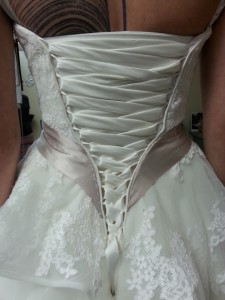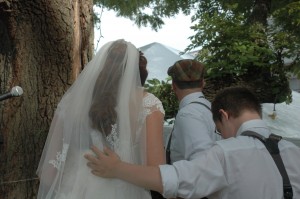There is a temptation at every stage of parenting to think that you have finally reached the end of the textbook. You feel sure that you now know all the wisdom that a parent would ever need. Well, I am here to tell you that that is simply not true! Those of you who read these blogs know that I am in the ‘grown-child- not fully out of the nest’ stage. This summer we celebrated a new rite of passage- the wedding (and marriage!) of one of our children. Looking wistfully at the pictures reminds me that it was glorious, joyous, amazing and all those adjectives that you could hope for. But the days and weeks leading up to the wedding gave me plenty of opportunity to think back on the challenges of parenting in contemporary society and all the pressures that bombard young children and their parents.
It all started with the first phone call looking for all the things a wedding seems to need – food, flowers and of course the dress. As soon as I said the word ‘wedding’, the sales pitch started, telling me in no uncertain terms that we needed to….well you can fill in the blank, but the lists went on and on and the costs got bigger and bigger.
Fortunately, I learned from my parents (and hopefully instilled in my kids) that making thoughtful decisions and staying true to self is more important than frilly drink straws or monogrammed coasters. The bridal couple worked hard to keep their thinking and decisions clear and grounded in reality. So while we worked to have a beautiful ceremony for my daughter to say ‘yes’ to her new husband, here are some thoughts I had about helping parents and children learn to say ‘no’. These ideas can work in your early childhood music groups, but will probably work just as well for parents in the store, at daycare or at home. Share them!
Set the stage for ‘yes’ more than ‘no’
Give children an environment which is safe and sturdy. Use instruments or toys that can be picked up and explored and tested. Set up the room or space so that children can use the entire space securely. If this is not possible, use mats or rugs or dividers to create a clear boundary. Look critically at everything in the environment. Ask yourself, ‘Can children play with this? Can children go there?’ Make sure the answer is ‘yes’ more than ‘no’.
Here is a little chant to use music to set the boundaries. “Inside the mats! That’s where it’s at!”
Make sure you know why you are saying ‘no’
Think long and hard before saying ‘no’. Is it for you or for the child? Try to use ‘no’ when it will help the child learn and grow in a healthy way. Issues of safety or the safety of another child might be a time to use the word ‘no’. If you find yourself saying (or thinking) ‘no’ because the child’s actions don’t fit your plan or your concept of how things should go, you might need to refocus the experiences you provide to be more developmental than task specific.
If the music experience is making shaking sounds, does it really matter if the child is shaking a maraca? Or a jingle bell? Or their toe?
Say ‘no’, then let it go
Adults often feel an emotional undercurrent when using the word ‘no’. We might be re-living moments when the word ‘no’ made us feel bad about ourselves. We might feel ambivalent or lack trust in our decisions for children. The best way to avoid this is to make ‘no’ a simple, clear signal without further repercussions. If saying ‘no’ is in the best interest of the child, then state it simply and clearly. This is the time to not use music or a musical, sing-song voice.
Stop the music, say ’no’ and then let it go. Get right back into the music to let the child know that ‘yes’ is usually a lot more fun than ‘no’.
So did I follow my own advice on ‘yes’ and ‘no’ for this wedding? Well, for the most part! And the Monday after, we looked back and were grateful that we were able to say ‘no’ to outside wedding pressures and thankful that we said ‘yes’ to the things that really mattered.
Beth


